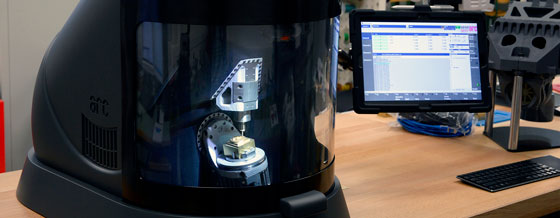
Receiving its world premiere at SIAMS last April, the 5-axis micromachine was developed by the Haute Ecole Arc Ingénierie.
This machine has the potential to revolutionise production in the field of microtechnology: it is small, energy-efficient, and works with exceptional rapidity and precision.
Why use giant machines to produce micro-engineering components? This is the question that triggered development of the micro5. As part of the thematic EcoSwissMade programme of the University of Applied Sciences Western Switzerland (HES-SO), Claude Jeannerat and his team accepted a challenge: to create a 5-axis machine capable of machining a 50 mm square cube while consuming a minimum of energy and without adversely affecting production quality.
«The 5-axis machines used to machine the caseband of a watch, for example, are hulking great things weighing several tonnes, with an installed power of 25 to 30 kW,» explains Claude Jeannerat, a professor at the Haute Ecole Arc Ingénierie. «We tried to design a machine whose dimensions would be more suited to the size of the parts they produce. The diameter of a watch caseband is less than 50 mm, and 400 W of power is enough to machine it.»
Basing themselves on the most recent scientific studies, Claude Jeannerat and his team of engineers reached the conclusion that the optimal ratio of workpiece size to machine structure was 1:5. All they had to do then was create a 5-axis machine the size of a coffee maker… What else?
«Ambient air suffices to keep this machining station at its optimal working temperature», explains Claude Jeannerat. «And, according to simulations, five minutes is enough for it to reach its operating temperature, whereas several hours are required for a machine weighing over a tonne».
The targeted objectives exceed all expectations: as well as obvious savings in terms of space in the production workshop, energy consumption is ten times lower. All this without the slightest loss of machining quality.
With the prices of industrial premises and energy expected to rise steeply in the future, the micro5 is an extremely promising innovation which could give the Jura region what it needs to stay competitive and at the same time meet environmental targets set by the Confederation.
Micromanufacturing also opens up prospects for industrial redeployment in outlying regions. If the size of machines is commensurate with the size of the parts they make, and factories adapt to the size of their machines, one can imagine factories on a human scale returning to de-industrialised localities.
June 02, 2016


 News
News